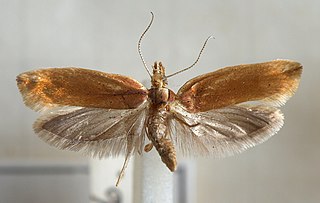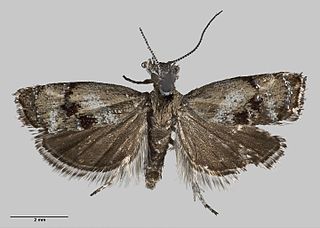
Epinotia solandriana is a moth of the family Tortricidae. It is found in Europe, China, Korea, Japan, and Russia.

Ypsolopha ustella, the variable ypsolopha moth, is a moth of the family Ypsolophidae. It is found in most of Europe and is also present in North America.

Glyphipterix schoenicolella is a species of moth of the family Glyphipterigidae. It is found in the Netherlands, Belgium, Bulgaria, Denmark, Estonia, France, Greece, Ireland, Italy, Latvia, Norway, Austria, Portugal, Russia, Slovakia, Spain, the Czech Republic, the United Kingdom and Sweden.

Zealandopterix zonodoxa is a moth of the family Micropterigidae. It is endemic to New Zealand and is located from Hawkes Bay north as well as on Poor Knights, Little Barrier and the Great Barrier Islands. It is the smallest micropterigid in New Zealand and the shiny white markings on the forewing of this species display variation. It is a moth that is active during the day, but has been collected using UV light. Adults are on the wing from September to March and the species has been witnessed visiting the flowers of Nīkau and Cordyline pumilio in large numbers. It inhabits a wide variety of moist indigenous forest but is associated with forests in which podocarps are common. Larvae have been sieved from rotten wood on the floor of a mixed podocarp/broadleaf forest or extracted from moss or from bryophytes.

Asterivora urbana is a species of moth in the family Choreutidae. It is endemic to New Zealand and has been observed in Arthur's Pass. Adults are on the wing in January.

Ancylis mitterbacheriana is a species of moth of the family Tortricidae. It is found in most of Europe, except the Iberian Peninsula, most of the Balkan Peninsula and Ukraine.

Dichrorampha alpinana, the broad-blotch drill, is a species of moth of the family Tortricidae. It is found in almost all of Europe.
Dichomeris procyphodes is a moth in the family Gelechiidae. It was described by Edward Meyrick in 1922. It is found in Amazonas, Brazil.
Helcystogramma adaequata is a moth in the family Gelechiidae. It was described by Edward Meyrick in 1914. It is found in Guyana.
Calliprora rhodogramma is a moth of the family Gelechiidae. It is found in Brazil (Amazonas).
Calliprora tetraplecta is a moth of the family Gelechiidae. It is found in Peru.
Calliprora platyxipha is a moth of the family Gelechiidae. It is found in Brazil.
Calliprora erethistis is a moth of the family Gelechiidae. It is found in Peru.
Calliprora peritura is a moth of the family Gelechiidae. It is found in Brazil (Para).
Calliprora pentagramma is a moth of the family Gelechiidae. It is found in Guyana.
Calliprora sexstrigella is a moth of the family Gelechiidae. It is found in North America, where it has been recorded from Arizona, California, New Mexico and Texas.
Aristotelia argyractis is a moth of the family Gelechiidae, which are commonly known as gelechiid or twirler moths. It was described by Edward Meyrick in 1923 and is found in Amazonas, Brazil.
Pyncostola pachyacma is a moth of the family Gelechiidae. It was described by Edward Meyrick in 1926. It is found in South Africa, where it has been recorded from the Western Cape.
Antaeotricha trichonota is a species of moth of the family Depressariidae. It is found in Brazil and Paraguay.
Antaeotricha walchiana is a moth of the family Depressariidae. It is found in Venezuela, Panama, Trinidad, Colombia, French Guiana, Brazil, Bolivia and Peru.






